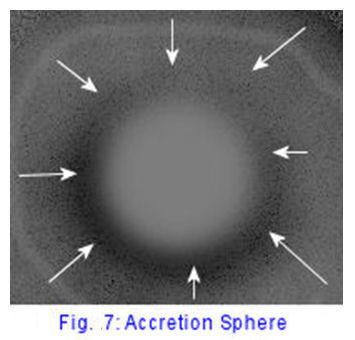|
Accretion Sphere

Let us look at the underlying process of star formation, since we posit that the laws of science are the same everywhere. Stars form when random matter drifts close and mutually attracts. Nature works in brute force, minimal-effort ways (like water seeking its proverbial lowest common level). When sufficient matter clumps together (80 or more Jupiters) we get a full-blown star, whose mass causes the reduction of hydrogen into a hot, formless plasma that gives off light and heat, as helium forms in the compression. As it happens, something like 80% of elemental matter in our universe is hydrogen. This fits neatly and predictably, since hydrogen is the simplest of the bright or visible elements. Next, much of the rest helium, with all else nearly an afterthought (we'll discuss this later in our go-dot process). Even the simplest element, and its irreducible unit or quark, is gigantic compared to the go-dots (dark matter, pure gravity) floating freely about. The gravitational sink created by a large entity like a star causes a distortion in the distribution of dark matter. Apparently (another subject for experiment or observation) the centrifugal pressure of light and heat emitted by the star more than offsets the centripetal clumping tendency of floating go-dots.
In the larger motherverse, the same type of process applies. When go-dots start clumping, they form an accretion sphere, whose shape is naturally dictated by the democracy of attraction. All units strive with equal success toward the core of the gravitational sink created by the nascent universe, which is as yet simply an accretion sphere of go-dots.
As more and more go-dots clump together, their combined and mutual attraction starts creating a gravity sink that 'vacuums' more and more go-dots on an ever-faster and more massive scale.
This is analogous to star formation, but on a much larger scale with much smaller discrete units. The accretion sphere is not yet a universe, but a sort of reverse-universe, like a sock that has to be turned inside out before one can wear it. The turning-inside out of the sock, by analogy, is the Big Bang moment in the Standard Model.

Infinitely many godots drift around the motherverse in random Brownian motion. Each godot is so small, and its gravitation identity so tiny, that any two godots have to be really close to one another to mutually stick. But stick they shall, under the right circumstances. In the aggregate, either discretely, in clumps, in accretion spheres, and within finished universes, godots are the fundamental element of the overall gravitation of the motherverse, which is the most powerful force in nature.
There is, logically, utter inevitability about this process. As more and more godots randomly cling together (just as the far more massive hydrogen molecules find each other inside the universe in empty space), accretion disks start forming. Once an accretion disk starts forming amid the essentially random and uniform distribution of go-dots in the motherverse, the process accelerates incrementally. The process takes on a life and inevitability of its own, and rushes faster and faster to its predictable conclusion as it 'vacuums' every available go-dot unto itself from an increasingly large surrounding volume of the motherverse.
Unimaginable but finite numbers of these very tiny go-dots, like the finest dust beyond imagination, end up building an entire universe—ours, and infinitely many, in an eternal cycle of accretion, explosion, and destructive attenuation.
The accretion sphere itself drifts around in the motherverse, slowly propelled by the aggregation of random kinetic energies of its component until at some point maybe it loses its random Brownian motion. It becomes a fixed point in the aggregate gravitation of the motherverse. However, more and more godots come drifting by.
Could we see this happening? For a time I thought not, but now I see no reason for there not to be at least the distant glow of functioning universes. So maybe there is a dim Gegenschein of some sort. We won't see the godots, but it's conceivable (a minor point here) that the accretion sphere may begin to emit some sort of energy, perhaps from all the accumulated kinetic energy of the random Brownian motion that now has nowhere to go. This should be detectable in the residual turbulence of the early universe, and herein may lie some opportunities for experimentation and observation that my expert requested.
As the accretion sphere continues growing, it becomes a space-time gravity sink in its own right, and starts vacuuming surrounding space clean of godots.
In fact, vacuum is a casual word used in the previous sentence, but it raises an interesting point—is the empty vacuum surrounding the accretion disk somehow translated into the universe that's about to form? I have no idea.
The accretion sphere grows and grows, until by some as yet unknown limits, it reaches the first of three critical events.



NOW AVAILABLE: The book (article) by John T. Cullen is now available for purchase at Amazon.com and other sites or stores. Visit:
|
E-Book
|
P-Book
|
Browse or Buy at Amazon
The book linked at left is an e-book edition to browse; or buy & download from Amazon for your Kindle reader.
The middle link is for the corresponding print edition. This short book is a standard 6x9" trim size. More info at Amazon.com.
Most print editions are also available at Barnes & Noble online; or call/visit your local bookstore to order.
|
TOP
|